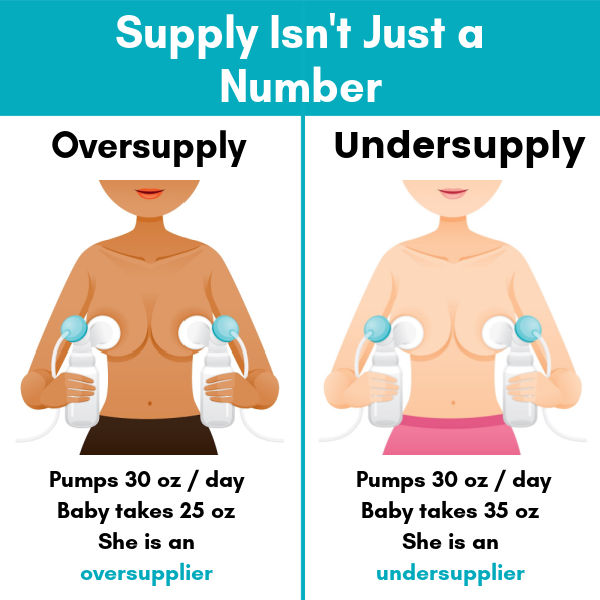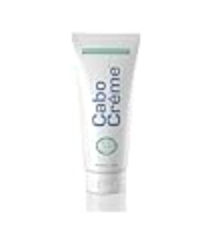What should you do when you have too much breast milk and want to reduce your milk supply? Here are seven ways to decrease your milk supply when you have an oversupply.

This post may contain affiliate links, which means that if you click a link and take action, I may make a small commission at no additional cost to you. I only recommend products I love! More info here.
How do you know if you have an oversupply of breast milk while exclusively pumping?
Basically, if you make more breast milk than your baby eats in a day, you’re an oversupplier. (Note: because milk supply varies over the course of a day, look at the amount that you pump over a 24 hour period rather than session by session.)
There are three basic categories of supply when it comes to exclusive pumping:
- Undersupplier (or Underproducer): Makes less breast milk than baby eats
- Just Enougher: Makes about the same as what baby eats, maybe with a small buffer of a few ounces
- Oversupplier (or Overproducer): Makes more than a few ounces more than what baby eats.
This means that two people can pump the exact same amount of milk, and one can be an undersupplier and one can be an overproducer.

So for example, say that Sally pumps 30 oz per day, and her baby eats 25 oz. Sally is an oversupplier.
On the other hand, Meg pumps 30 oz per day, but her baby eats 35 oz. Meg is an undersupplier.
What issues can an oversupply of breastmilk cause?
There are a few issues that having an oversupply can cause. Often, these issues present less of a problem for exclusive pumpers than for those that nurse, but they can still occur.
Possible complications of oversupply can include:
Forceful letdown
Sometimes, during letdown, too much milk can come out at once for baby to handle. This can be frustrating for the baby, especially since they often get sprayed in the face.
If you’re exclusively pumping, this complication of oversupply will not be a problem for you! Your breast pump can handle whatever letdown you give it.
Foremilk/hindmilk imbalance
Foremilk is the milk at the start of a session, and tends to be less fatty than the hindmilk at the end.
If a baby fills up on foremilk (because there is so much of it) before she can get to the hindmilk, this can cause foremilk/hindmilk imbalance.
This tends to be less of an issue for exclusive pumpers, because the milk is all mixed together in a bottle, but some people do still struggle a bit.
Many find that the pitcher method is helpful in managing foremilk/hindmilk imbalance when exclusively pumping.

Recurrent clogged ducts/mastitis
Anyone who is breastfeeding – undersupplier, just enougher, or oversupplier – can struggle with recurrent clogged ducts or mastitis.
However, it may be a bit more of a issue for overproducers because they have more milk that needs to be removed when they lactate. This means that cutting a nursing or pumping session short can sometimes lead to milk getting “stuck.”
How to decrease milk supply when you’re not weaning (versus when you are weaning)
If you’re trying to decrease milk supply when you’re NOT weaning, I recommend being very cautious.
(If you’re exclusively pumping, unless you are struggling with one of the above issues, I generally advise not trying to decrease your milk supply – more on this here.)
I’ve ordered the below strategies from baby steps to most effective. If you are not weaning and just trying to curb production, start with the baby steps, and make sure to go slowly and watch how your body is responding before continuing.
If you are weaning and trying to completely dry up your milk supply, feel free to go all out and choose whatever method you’d like.
How to Decrease Your Milk Supply
Here are several things that you can do to reduce your milk supply, from least drastic to most effective.
1. (Gradually) Pump Less Milk
The most important thing that you can do to pump less milk is: pump less milk.
Breastfeeding is a supply and demand process, so the more milk that you remove from your breasts via the pump, the more milk your body thinks it needs to make.
The trick is to pump less milk gradually, so that your body gets the message that it should ramp down production.
There are a few different ways that you can approach this, and I’ve covered them in more detail in a post on dropping pumping sessions. For example, you can slowly reduce the volume that you pump in a given pumping session, or you can completely drop a pumping session.
More information on how to drop a pumping session here.
2. Try Cabbage Leaves
There hasn’t been a lot of research done to show why cabbage may reduce milk supply, but it is often recommended by lactation consultants and doctors to provide relief from engorgement and reduce milk supply.
One theory is that the amnio acids in the cabbage help to decrease tissue congestion by opening capillaries and improving the blood flow in and out of the engorged breast, relieving inflammation and allowing the milk to flow freely.
I wrote a step-by-step overview of how to use cabbage, but the short version is: to use a cabbage leaf, wash it and slice off the tops of the vein with a knife. Then put it in your bra. You’ll want to leave it in there until it wilts – about 20-30 minutes – and repeat often.
People who have engorgement are instructed to do this three to four times in a 24 hour period to reduce engorgement without losing milk supply. Since you are trying to decrease your milk supply, you may want to do it more often.
(If you have cracked or bleeding nipples, hold off on using cabbage until that has healed.)

In addition to cabbage, I wanted to mention Cabocreme (a cream with concentrated cabbage extract). It’s is more expensive than cabbage, but lots of moms in our Facebook group find it easier to use and see the same results.
3. Eat Peppermint
Peppermint is an herb that may decrease milk supply in larger doses.
A few peppermint candies or menthol cough drops probably won’t make your milk supply plummet, but in larger quantities, it might have an effect. Start small and see if you notice your milk supply starting to drop.
4. Eat or Drink Sage
Like peppermint, sage is one of a few herbs that can decrease milk supply. There are a few different ways that you can consume it:
- You can use dried sage from your spice rack to make tea or ingest directly, or
- You can take capsules.
To make sage tea, put one teaspoon of dried sage in one cup boiling water and steep for 15 minutes.
You can also eat it directly by mixing it in with other foods, or, if you don’t like the taste, putting about 1/4 tsp of it on something sticky (like honey on a very small piece of bread) and try to swallow it like a pill.
5. No More Milk Weaning Tea
This tea contains sage, peppermint, and parsley, and is intended to help speed the weaning process. Basically, it’s a packaged way to get the more powerful anti-milk supply herbs.
No More Milk Tea might be a little more palatable than sage capsules or tea or eating large quantities of candy canes. Again, start slowly.
6. Birth Control Containing Estrogen
Birth control products that contain estrogen, such as Nuva Ring or oral combination birth control pills, may have a negative effect of breast milk supply.
If you are weaning and planning to start taking birth control with estrogen anyway, it might make sense to time it so that you start your new birth control when you start weaning.
(I wouldn’t recommend trying this unless you are weaning, as the effect might be greater than you’d like and it may be complicated for you to stop taking it.)
7. Take Sudafed
For some women, taking pseudoephedrine (the active ingredient in Sudafed) will reduce milk supply – a small study of lactating women showed that one dose of Sudafed reduced milk supply over the next 24 hours by 24%.
Unless you are weaning or have significant negative effects from oversupply, use caution with reducing supply with Sudafed, as the effect will vary from person to person, and you don’t know how it will affect you until you try it.
In the United States, Sudafed is sold in most pharmacies behind the pharmacy counter, but you don’t need a prescription.
Have you tried to decrease your milk supply? Let us know how it went for you in the comments.
Thinking about weaning from the pump? No idea where to start? Worried that you’ll get a clogged duct or mastitis when you stop pumping? Grab my one-of-a-kind guide here.
References- Bonyata, Kelly, IBCLC. “How does milk production work?” https://kellymom.com/hot-topics/milkproduction/
- Aljazaf, Khalidah. “Pseudoephedrine: effects on milk production in women and estimation of infant exposure via breastmilk.” https://www.ncbi.nlm.nih.gov/pmc/articles/PMC1884328/
- Smith, Sandra. “Cabbage Leaves for Treatment and Prevention of Breast Engorgement.” https://www.breastfeedingonline.com/cabbage.shtml#sthash.I9qKNMdh.ZziI8Pk1.dpbs















